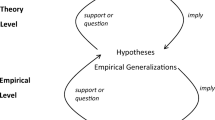Abstract
The history of the diffusion and confirmation of Mendeleev’s periodic table of elements has proven to be a challenging testbed for contemporary philosophical debates on the role of predictions in science. More than ten years of fruitful literature came after Scerri and Worrall (Stud Hist Phil Sci 32(3):407–452, 2001) versus Maher (Proc Bienn Meet Philos Sci Assoc 1:273–285, 1988) and Lipton (Inference to the best explanation, 2004 edition, Routledge, London, 1991); nevertheless, such a long-lasting debate left quite a few open questions. The aim of this contribution is to go through the various cases that emerged during the debate, in an effort to explain them coherently in a weak predictivist perspective. Maher’s early account—according to which the astounding success of the major predictions alone was enough to explain the confirmation of the periodic table—can now be replaced by a more balanced and thorough picture, where both predictions and accommodations do weight.
Similar content being viewed by others
Notes
The predictivist account maintains that successful predictions of novel evidence carry more confirmatory weight than accommodations of already known evidence.
See, e.g., Stewart (2019).
The measured specific heat for beryllium was consistent with an atomic weight of 14 through the Dulong-Petit law. It was later found that such an experimental relation failed at room temperature for metallic beryllium.
Schindler calls it Worrall’s parameter-fixing account (p. 64).
It is not hard to recognize the Lakatosian root of Worrall’s argument: ad hoc accommodated evidence is granted some (actually a lot of) epistemic weight as long as the research program as a whole remains progressive—which is proven by the success of the new predictions that follow the accommodation.
The Danish chemist Jörgen Thomsen had actually predicted the possibility of a group of completely unreactive elements (see also Scerri 2007, p.151—endnote 58). Nevertheless, such a prediction does not seem to have influenced the subsequent developments of the noble gas debate.
A null valence was problematic for the determination of the atomic weight of the element according to the formula: atomic weight = valence x equivalent weight.
Argon's mono-atomicity was supported by a measurement of the ratio between the specific heats at constant pressure and at constant volume which had come out equal to 1.66—meaning that the molecule had only translational energy.
According to Giunta (2001), Ramsey predicted the existence of other three inert gases in 1896 and “made a more explicit and public prediction of […] a monoatomic gas of atomic weight about 20” in 1897 (p. 121).
Analogous elements in a group—e.g., the alkali metals—share similar chemical and physical properties while possessing different atomic weights.
As reported by Smith (1976), Mendeleev deemed Brauner’s solution “as one of three subjects which concern the periodic law but which are not yet in agreement with it" (p.433)—the other two being the pair reversal anomalies.
Moseley claimed that each element is identified by its atomic number instead of its atomic weight, thus resolving most of Mendeleev’s anomalies.
This reminds Lakatos’ (1978) standpoint about refutations in science: “scientists do not abandon a theory merely because facts contradict it […] If they cannot explain the anomaly, they ignore it and direct their attention to other problems” (p. 4).
References
Akeroyd, F.M.: Prediction and the periodic table: a response to Scerri and Worrall. JGPS 34(2), 337–355 (2003)
Alai, M.: Novel predictions and the no miracle argument. Erkenntnis 79, 297–326 (2014)
Bensaude-Vincent, B.: Mendeleev's periodic system of chemical elements. BJHS 19(1), 3–17 (1986)
Brush, S.G.: The reception of Mendeleev's periodic law in America and Britain. Isis 87(4), 595–628 (1996)
Giunta, C.J.: Argon and the periodic system: the piece that would not fit. FOCH 3, 105–128 (2001)
Gordin, M.D.: Making newtons: Mendeleev, metrology, and the chemical ether. Ambix 45(2), 96–115 (1998)
Lakatos, I.: The methodology of scientific research programmes. In: Worrall, J., Currie, G. (eds.) Imre Lakatos Philosophical Papers (1989 ed.). Cambridge University Press, New York (1978)
Lipton, P.: Inference to the Best Explanation (2004 ed.). Routledge, London (1991)
Maher, P.: Prediction, Accommodation, and the Logic of Discovery. PSA Proc. Bienn. Meet. Philos. Sci. Assoc. 1, 273–285 (1988)
Scerri, E.R.: The Periodic Table: Its Story and Its Significance. Oxford University Press, New York (2007)
Scerri, E.R., Worrall, J.: Prediction and the periodic table’. Stud. Hist. Phil. Sci. 32(3), 407–452 (2001)
Schindler, S.: Use-novel predictions and Mendeleev’s periodic table: response to Scerri and Worrall (2001). Stud. Hist. Phil. Sci. 39, 265–269 (2008)
Schindler, S.: Novelty, coherence, and Mendeleev’s periodic table. Stud. Hist. Phil. Sci. 45, 62–69 (2014)
Smith, J.R.: Persistence and periodicity: A study of Mendeleev’s contribution to the foundations of chemistry (unpublished Ph.D. thesis). University of London, London (1976)
Stewart, P.J.: Mendeleev’s predictions: success and failure. FOCH 21, 3–9 (2019)
Thyssen, P., Binnemans, K.: Accommodation of the rare earths in the periodic table: a historical analysis. In: Gschneidner, K.A. (ed.) Handbook on the Physics and Chemistry of Rare Earths. Academic Press, Burlington (2011)
Thyssen, P., Binnemans, K.: Mendeleev and the rare-earth crisis. In: Scerri, E., McIntyre, L. (eds.) Philosophy of Chemistry: Growth of a New Discipline (2015 ed.). Springer, Dordrecht (2014)
Worrall, J.: Prediction and the ‘periodic law’: a rejoinder to Barnes. Stud. Hist. Phil. Sci. 36, 817–826 (2005)
Acknowledgements
The author would like to warmly thank Vincenzo Crupi (Università di Torino, Italy) for his invaluable inputs, feedbacks, and encouraging suggestions on the development of this research. Many thanks are also due to the anonymous referees who provided useful suggestions and helped the author to express his thoughts more clearly.
Author information
Authors and Affiliations
Corresponding author
Additional information
Publisher's Note
Springer Nature remains neutral with regard to jurisdictional claims in published maps and institutional affiliations.
Rights and permissions
About this article
Cite this article
Sereno, S.G.M. Prediction, accommodation and the periodic table: a reappraisal. Found Chem 22, 477–488 (2020). https://doi.org/10.1007/s10698-020-09371-7
Published:
Issue Date:
DOI: https://doi.org/10.1007/s10698-020-09371-7




